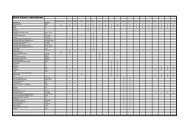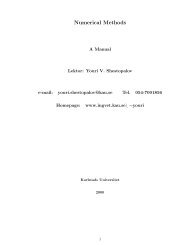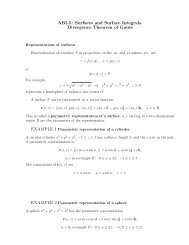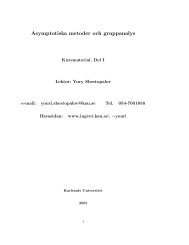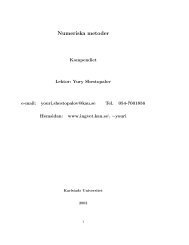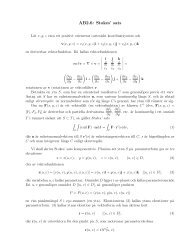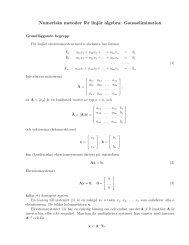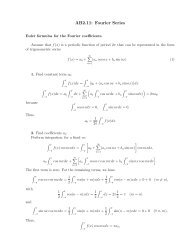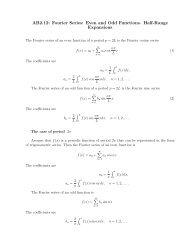Create successful ePaper yourself
Turn your PDF publications into a flip-book with our unique Google optimized e-Paper software.
From Green’s first formula applied to a pair of (harmonic) functions u, v = u and the interiorD h of a surface Γ h = {x − hn x : x ∈ Γ} parallel to the Ds boundary Γ with sufficiently smallh > 0,∫ ∫∫(u∆u + |grad u| 2 )dx = u ∂u dl y , (265)∂n yD h Γwe have first∫ ∫(because B ∈ D h ); next we obtainB∫ ∫D h∫ ∫|grad u| 2 dx ≤∫|grad u| 2 dx ≤Passing to the limit h → 0 we obtain a contradiction∫ ∫|grad u| 2 dx ≤ 0.Hence, the difference u = u 1 − u 2 must be constant in D.14 Potentials with logarithmic kernelsIn the theory of boundary value problems, the integrals∫∫u(x) = E(x, y)ξ(y)dl y , v(x) =CBΓD h|grad u| 2 dx, (266)u ∂u∂n ydl y = 0. (267)C∂∂n yE(x, y)η(y)dl y (268)are called the potentials. Here, x = (x, y), y = (x 0 , y 0 ) ∈ R 2 ; E(x, y) is the fundamental solutionof a second-order elliptic differential operator;∂∂n y=is the normal derivative at the point y of the closed piecewise smooth boundary C of a domainin R 2 ; and ξ(y) and η(y) are sufficiently smooth functions defined on C. In the case of Laplace’soperator ∆u,g(x, y) = g(x − y) = 12π ln 1|x − y| . (269)In the case of the Helmholtz operator H(k) = ∆ + k 2 , one can take E(x, y) in the form∂∂n yE(x, y) = E(x − y) = i 4 H(1) 0 (k|x − y|),where H (1)0 (z) = −2ig(z) + h(z) is the Hankel function of the first kind and zero order (oneof the so-called cylindrical functions) and 1 1g(x − y) =2 2π ln 1is the kernel of the twodimensionalsingle layer potential; the second derivative of h(z) has a logarithmic|x − y|singularity.51



